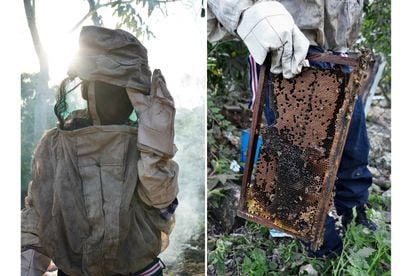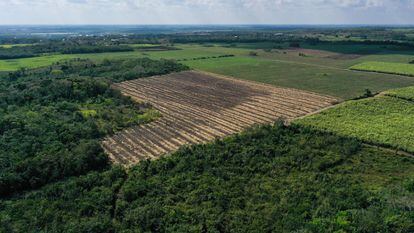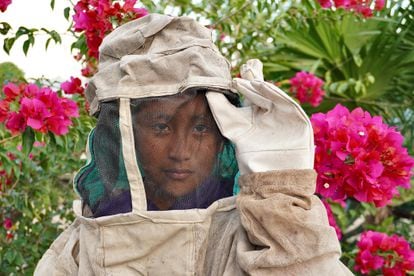EL PAÍS offers the América Futura section openly for its daily and global information contribution on sustainable development. If you want to support our journalism, subscribe here.
Jonathan Lorenzo Reyes's only hive seems lonelier when you look at the immensity that surrounds it. The modest honey-producing colony that this 10-year-old beekeeper takes care of in the backyard of his house is in the middle of a monoculture of 35,500 hectares of sugar cane, on which tons of fertilizers and pesticides are sprayed for replanting and then It goes up in flames as part of the harvesting process. Fire, chemicals and deforestation threaten the survival of bees, one of the most important pollinators in the world, in the sugarcane region of Quintana Roo, in the last and forgotten corner of the Mexican southeast.
Jonathan, the beekeeper boy, lives in José Narciso Rovirosa, one of the 14 agricultural ejidos in the sugarcane region. The crops in this region extend for almost 100 linear kilometers that run parallel to the Hondo River, the natural border with Belize. Here, 1.6 million tons of sweet cane are produced each season, then ground in a private mill, where they are processed into standard sugar, honey and compost. Sales of this industry are estimated at 1.5 billion pesos annually (about 90 million dollars), according to the Secretariat of Agricultural, Rural and Fisheries Development of Quintana Roo. To achieve this, more than 3,000 cane producers are required, 3,000 day laborers during the harvest, 460 workers in the sugar mill and another 25,000 derivative and indirect jobs. It is one of the main economies of the Mexican Caribbean, only below tourism and construction.
Half a century ago, everything around was medium and low jungle. Before former Mexican president Gustavo Díaz Ordaz launched a plan to promote sugar cane monoculture on what is considered the second most important forest massif on the continent, this was full of bee flora that bees used to visit in search of pollen and nectar. The capulín, palo mulato, cacahuananche, sapote, caimito or chicle trees are no longer found, nor are the long-stemmed herbs topped with colorful flowers that bees love so much, according to research from the Quintana Roo Technological Institute, carried out by the biologist Darwin Jesús Pech Pool. Now, the only thing that can be seen thousands of kilometers around is a single type of plant, a robust, elongated one, rich in sucrose and a very few hives.
Jonathan says that he learned beekeeping from his grandfather, a man from Oaxaca who migrated to the sugarcane region to work as a day laborer working miserable days of more than 15 hours a day, but who very soon fell in love with bee farming until it became one of his main activities. “I became interested in bees since I was little, because of my grandfather Fortunato, may he rest in peace. He taught me agriculture and the cultivation of bees. He taught me how to scare them away with smoke. “He amused me a lot,” says this cheeky boy, with black hair, dark skin and slanted eyes.
Grandfather died in 2020 of cardiac arrest, but before that he inherited Jonathan a hive with which this March afternoon he intends to replicate the methods learned to show how honey is extracted. It is a small blue wooden box with a white lid with thousands of bees inside. “Jonathan, but put on the suit and gloves. “Go get your jeans and your high boots,” Rutlia, his mother, orders from afar, about the special clothing that will protect him from bites. As she gets ready, she explains that each of the 30 beekeepers still surviving in the region has developed different methods of extracting honey.
He says that before handling the hives, it is necessary to spray smoke to force the bees to come out and thus be able to maneuver without risk to anyone. Rutilia is careful. “I usually arrive and greet them. It's as if you came to greet your children. The way you greet them, they will understand you. I even tell them that I'm going in: hello, good afternoon or good morning, I'm here, today we're going to work, I hope you behave well,” she says. “I use dried coyol fruit a lot in the smoker; I add basil, I add oregano and that's it, I turn it on. I don't use wood because that bothers them. Basil is useful, for example, in case the bee has a cough,” she says while she prepares the formula and gives notice to her son that she can start the task.
Jonathan is dressed in his old and worn, but effective mesh fabric suit, which covers him from head to waist, some synthetic leather gloves, his jeans, and his size 4 boots that are already starting to feel tight. He takes the smoker and warns his two-year-old younger brother to stay away from him because he has no protection, but she ignores him and follows him, curious. He arrives at the hive located in his backyard, in the same place where they collect waste and then burn it, since there is no garbage collection system here, it pours smoke and the bees come out in a matter of seconds. At that moment you can only hear the humming and the crying of his brother, which breaks out into bites in the ear and hands. Jonathan struggles to uncover the hive. “The last time we opened this hive was with my grandfather, that's why it's hard,” he says, pushing. And finally he takes out one of the six panels.
The panels are wooden frames with wires in the middle that hold a layer of wax on which bees build hives to raise and deposit honey. Once outside, cuts are made to the honeycomb flush with the frame and this material is stored in a can. Then, the surplus is extracted using a centrifugal method. Finally, everything is strained and the extracted amber, dense and sweet liquid is placed in containers for sale.

In February, May and November, Rutilia does the same thing, but with the eight colonies she has in a lot 20 minutes from her house. “The area I have is the only green one, because everything else is cane. I call it ranchito,” she says. Now it's all reeds, a landscape
very different from when she was a child and that area was surrounded by jungle. “And every planting season, the bees decrease. They die when they pass by where they fertilize. Before we had, I'll tell you, more than 50 colonies, but they have decreased. It is increasingly difficult for them to survive,” she says.
They have decreased because the bees do not find the jungle and its bee flora nearby for foraging, but also because from 1979 to 2016, 86,200 kilograms of fertilizer per hectare have been poured into the sugarcane growing area, according to research by El Colegio de la Frontera Sur, made by Ana Cecilia Iuit Jiménez. According to this environmental engineer, producers spray fertilizers such as Formula 20023, Formula 11 and Urea. Also pesticides such as Nuvacrón, Malathion and Hierbamina, restricted or prohibited by the international community due to their toxicological effects on human health and the environment, highly lethal for bees, maintains the author.
The situation is serious, considering that Quintana Roo is the seventh national producer of honey, with a contribution of more than 3,000 tons annually, according to data from the Ministry of Environment and Natural Resources (Semarnat). And in the Yucatan Peninsula there are 750,000 beehives (35% of the national total).
Bees and beekeeping are fundamental not only for the family economy in rural areas, but are key to the conservation of biodiversity. These insects pollinate countless plants during foraging. It is something that Jonathan is clear about. “One can live because bees pollinate and when they pollinate they also pollinate the trees and we need those trees to breathe,” he says.

Hatsumi and the end of a generation of beekeepers
Hatsumi Guadalupe Serrano, 12 years old, is an only child. The intention of Nazario Serrano, her father, was for her to learn everything about bee farming, continue the family tradition and thus prevent beekeeping from becoming extinct in the sugarcane growing area of Quintana Roo, but Hatsumi turned out to be allergic. She still remembers the picket, how swollen she became and how she almost suffocated when she was a little girl of just three years old. Since then, she has been prohibited from returning to the apiary.
With Hatsumi an entire generation of beekeepers in the sugarcane area ends. Without it, sugar cane will gain more ground. The great-great-grandfather of this high school student was a Chinese enslaved in the Yucatan Peninsula who managed to escape to the sugarcane region when everything was still jungle. Here he learned to be free by cultivating bees, a tradition that she taught to his son, and he in turn taught Nazario, Hatsumi's father. “We were one of the pioneers in Rovirosa. Also one of the first to do beekeeping,” says Nazario, 47 years old.
Nazario does the math quickly and says that when he was a child in Rovirosa there were about 50 beekeepers. Today there are only three left: them, Jonathan's family, the beekeeper boy, and another neighbor. “Beekeeping is becoming more and more difficult. The others stopped doing it and have dedicated themselves to sugar cane,” laments the man. And he says that he has had to install the 200 hives he has further and further away to protect the bees from agrochemicals. “My dad's apiaries were 5 kilometers from here, at most. Currently, they are much further removed, because there are reeds and less vegetation, because they already spray chemicals even with drones. Now they are retired. They are already 15 or 20 kilometers from here.”
They also have to be installed further away to protect them from arson. Field work here is divided into two seasons. From July to October the land is prepared for the sugar cane to sprout, and from November to June the harvest happens. Before harvesting, tests are done in each field to verify that the cane is ripe. When it is ready, controlled fires are carried out, with the aim of removing the leaves from the stems and thus facilitating cutting and increasing productivity.
That heat and smoke not only kills the bees, but also affects the quality of the honey. “Before there was so much cane cultivation, a transparent honey was collected, clear in color, but right nowSince there is no flowering nearby, they go to the sugarcane to collect the sweat, the little juice from the sugarcane that sweats when the fields are burned, and they take it to the colony. From there the quality and color changes, because it is darker and the flavor is stronger. When you try it, you feel like it burns your throat, it tastes like panela and is denser. And well, it brings all the chemicals they use for burning and planting,” says Nazario.

This explains why the sales price has also dropped, because the lower the quality, the less money they receive, in an already punished market, says Nazario. “Before they paid up to 50 pesos per liter; Today they don't even give 20. That's not even enough to cover the expenses of the honeycombs,
the material to extract the honey, the salaries of the kids who help us, the gasoline to go to the apiaries… We do it almost almost. for love, because it's not even a business anymore.”
Although Hatsumi no longer goes to the family bee farm, she sometimes helps her father maintain all the tools they use. She may not be a beekeeper, but perhaps this preteen, great-great-granddaughter of a slave and daughter of a beekeeper in trouble can also defend life in another way. “I want to be a lawyer, to defend the people of the town, to advocate for them, to defend my town,” she says.
#child #beekeeper #line #defense #monoculture #border #Belize
